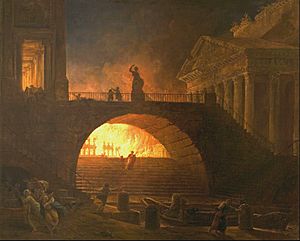Great Fire of Rome facts for kids

The Great Fire of Rome was a huge fire that happened in July, 64 AD. It started in shops near Rome's big chariot stadium, the Circus Maximus, on the night of July 19. After six days, people thought the fire was under control. But before they could check the damage, it started burning again for three more days! When it finally stopped, two-thirds of Rome was destroyed.
According to the historian Tacitus and later Christian stories, Emperor Nero blamed the fire on the Christian community in the city. This led to the first persecution against Christians in the Roman Empire. However, some modern historians, like Brent Shaw, think that Nero might not have blamed the Christians after all.
Contents
Who was involved?
Emperor Nero
Nero became emperor in 54 AD when he was just 16 years old. His rule is often remembered for being impulsive and sometimes unfair. At first, he listened to advice from others, but he slowly started making his own decisions. After the Great Fire of Rome in 64 AD, many people whispered that Nero had ordered the fire himself. They thought he wanted to clear space to build a grand new palace.
Tacitus, the historian
Publius Cornelius Tacitus was a Roman senator and a very important historian. He was born around 56 or 57 AD. His two main books, the Annals and the Histories, tell the story of the Roman Empire from 14 AD to 96 AD. Sadly, much of his work is now lost. Tacitus was only about 8 years old when the Great Fire happened. But he used public records and reports to write a detailed account of the event.
How the fire spread
Tacitus wrote that the fire began in shops where things that burn easily were stored. These shops were near the Circus Maximus, close to the Caelian and Palatine Hills of Rome. It was a very windy night, and the flames quickly spread all along the Circus.
The fire moved fast through a part of ancient Rome with narrow, winding streets and buildings packed closely together. In this area, there were no big open spaces or large stone buildings like temples to stop the flames. So, the fire kept spreading up the Palatine and Caelian hills. People ran away, first to areas not yet burning, and then to the open fields outside the city. Some reports said that looters and people who wanted to cause trouble actually helped spread the fire by throwing torches. They also stopped others from trying to put out the flames. The fire finally stopped after six days of burning non-stop. But then, it started up again and burned for three more days!
What happened after
Tacitus said that Nero was not in Rome when the fire started; he was in a town called Antium. When Nero returned to the city, he quickly took action. He brought in food supplies and opened up gardens and public buildings to help the people who had lost their homes.
Out of Rome's 14 areas, 3 were completely destroyed. Seven more were left as scorched ruins, and only 4 areas escaped any damage at all. The fire destroyed almost everything it touched. This was because many homes were poorly built with wood. Important buildings like the Temple of Jupiter Stator, the House of the Vestals, and Nero's own palace, the Domus Transitoria, were all burned down. The part of the Forum where Roman senators lived and worked was also destroyed. However, the open area in the middle of the Forum remained and became a busy place for business.
People's suspicions that Nero had started the fire grew stronger because he was so quick to rebuild the burned areas. He rebuilt them in a Greek style and started building his huge new palace. This new palace, called the Golden House, would have been enormous, covering a third of Rome!
Different stories about the fire
We don't have many original stories from people who lived through the fire. Most of what we know comes from three later historians: Cassius Dio, Suetonius, and Tacitus. Because of this, there are several different ideas about what happened and Nero's role:
- Some believed Nero secretly sent people to start the fire because he wanted to destroy the city. They said he watched from his palace, singing and playing music.
- Another idea was that Nero wanted to destroy the city so he could rebuild Rome exactly how he wanted it, without needing permission from the Senate.
- Some rumors said Nero openly sent people to start the fire and watched from a tower, singing.
- There were also unconfirmed rumors that Nero sang from a private stage during the fire.
- Many believed the fire was just an accident that happened while Nero was away from Rome.
- Finally, because rumors spread that Nero had started the fire, he was said to have blamed the already unpopular Christians to take the blame off himself.
See also
 In Spanish: Gran incendio de Roma para niños
In Spanish: Gran incendio de Roma para niños

